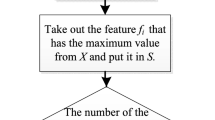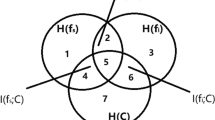Abstract
The performance of many feature selection algorithms is affected because of ignoring three-dimensional mutual information among features. Three-dimensional mutual information includes conditional mutual information, joint mutual information and three-way interaction information. Aiming at the limitation, this paper investigates feature selection based on three-dimensional mutual information. First, we propose an objective function based on conditional mutual information. Further, we propose a criterion to validate whether the objective function can guarantee the effectiveness of selected features. In the case that the objective function cannot guarantee the effectiveness of selected features, we combine a method of equal interval division and ranking with the objective function to select features. Finally, we propose a feature selection algorithm named EID-CMI. To validate the performance of EID-CMI, we compare it with several feature selection algorithms. Experimental results demonstrate that EID-CMI can achieve better feature selection performance.

Similar content being viewed by others
Explore related subjects
Discover the latest articles, news and stories from top researchers in related subjects.References
Bolon CV, Sanchez MN, Alonso BA (2015) Recent advances and emerging challenges of feature selection in the context of big data. Knowl-Based Syst 86:33–45
Borja SP, Veronica BC, Amparo AB (2017) Testing different ensemble configurations for feature selection. Neural Process Lett 46:1–24
Estevez PA, Tesmer M, Perez CA, Zurada JM (2009) Normalized mutual information feature selection. IEEE Trans Neural Netw 20(2):189–201
Vergara JR, Estevez PA (2014) A review of feature selection methods based on mutual information. Neural Comput Appl 24(1):175–186
Brown G, Pocock A, Zhao MJ, Lujan M (2012) Conditional likelihood maximisation: a unifying framework for information theoretic feature selection. J Mach Learn Res 13:27–66
Lewis DD (1992) Feature selection and feature extraction for text categorization. In: Proceedings of the Workshop on speech and natural language, pp 212–217
Battiti R (1994) Using mutual information for selecting features in supervised neural net learning. IEEE Trans Neural Netw 5(4):537–550
Kwak N, Choi CH (2002) Input feature selection for classification problems. IEEE Trans Neural Netw 13(1):143–159
Peng HC, Long FH, Ding C (2005) Feature selection based on mutual information: criteria of max-dependency, max-relevance and min-redundancy. IEEE Trans Pattern Anal Mach Intell 27(8):1226–1238
Foithong S, Pinngern O, Attachoo B (2012) Feature subset selection wrapper based on mutual information and rough sets. Expert Syst Appl 39(1):574–584
Wang ZC, Li MQ, Li JZ (2015) A multi-objective evolutionary algorithm for feature selection based on mutual information with a new redundancy measure. Inf Sci 307:73–88
Gu XY, Guo JC, Xiao LJ, Ming T, Li CY (2020) A feature selection algorithm based on equal interval division and minimal-redundancy maximal-relevance. Neural Process Lett 51(2):1237–1263
Sun X, Liu YH, Xu MT, Chen HL, Han JW, Wang KH (2013) Feature selection using dynamic weights for classification. Knowl-Based Syst 37:541–549
Zeng ZL, Zhang HJ, Zhang R, Yin CX (2015) A novel feature selection method considering feature interaction. Pattern Recogn 48(8):2656–2666
Yang HH, Moody J (1999) Data visualization and feature selection: new algorithms for non-gaussian data. In: Proceedings of conference on neural information processing systems
Fleuret F (2004) Fast binary feature selection with conditional mutual information. J Mach Learn Res 5:1531–1555
Lin DH, Tang X (2006) Conditional infomax learning: an integrated framework for feature extraction and fusion. In: Proceedings of European conference on computer vision, pp 68–82
Bennasar M, Hicks Y, Setchi R (2015) Feature selection using joint mutual information maximisation. Expert Syst Appl 42(22):8520–8532
Vinh NX, Zhou S, Chan J, Bailey J (2016) Can high-order dependencies improve mutual information based feature selection. Pattern Recogn 53:46–58
Jakulin A, Bratko T (2004) Testing the significance of attribute interactions. In: Proceedings of international conference on machine learning, pp 409–416
Yu L, Liu H (2004) Efficient feature selection via analysis of relevance and redundancy. J Mach Learn Res 5:1205–1224
Lichman M (2013) UCI Machine learning repository. University of California, Irvine, School of Information and Computer Sciences
Li JD, Cheng KW, Wang SH, Morstatter F, Trevino RP, Tang JL, Liu H (2018) Feature selection: a data perspective. ACM Comput Surv 50(6)
Fayyad U, Irani KB (1993) Multi-interval discretization of continuous-valued attributes for classification learning. In: Proceedings of international joint conference on artificial intelligence, pp 1022–1027
Hall M, Frank E, Holmes G, Pfahringer B, Reutemann P, Witten IH (2009) The WEKA data mining software: an update. ACM SIGKDD Explor Newsl 11(1):10–18
Zhao Z, Morstatter F, Sharma S, Alelyani S, Anand A, Liu H (2010) Advancing feature selection research. ASU feature selection repository 1–28
Herman G, Zhang B, Wang Y, Ye GT, Chen F (2013) Mutual information-based method for selecting informative feature sets. Pattern Recogn 46(12):3315–3327
Ren JF, Jiang XD, Yuan JS (2015) Learning LBP structure by maximizing the conditional mutual information. Pattern Recogn 48(10):3180–3190
Wang J, Wei JM, Yang ZL, Whang SQ (2017) Feature selection by maximizing independent classification information. IEEE Trans Knowl Data Eng 29(4):828–841
Tang B, Kay S, He HB (2016) Toward optimal feature selection in Naive Bayes for text categorization. IEEE Trans Knowl Data Eng 28(9):2508–2521
Zhang F, Chan PPK, Biggio B, Yeung DS, Roli F (2016) Adversarial feature selection against evasion attacks. IEEE Trans Cybernet 46(3):766–777
Fei T, Kraus D, Zoubir AM (2012) A hybrid relevance measure for feature selection and its application to underwater objects recognition. In: Proceedings of international conference on image processing, pp 97–100
Fei T, Kraus D, Zoubir AM (2015) Contributions to automatic target recognition systems for underwater mine classification. IEEE Trans Geosci Remote Sens 53(1):505–518
Gu XY, Guo JC (2019) A study on Subtractive Pixel Adjacency Matrix features. Multimedia Tools Appl 78(14):19681–19695
Gu XY, Guo JC, Wei HW, He YH (2020) Spatial-domain steganalytic feature selection based on three-way interaction information and KS test. Soft Comput 24(1):333–340
Veronica BC, Noelia SM, Amparo AB (2013) A review of feature selection methods on synthetic data. Knowl Inf Syst 34(3):483–519
Acknowledgements
This work was supported by the National Natural Science Foundation of China (61771334).
Author information
Authors and Affiliations
Corresponding author
Additional information
Publisher's Note
Springer Nature remains neutral with regard to jurisdictional claims in published maps and institutional affiliations.
Rights and permissions
About this article
Cite this article
Gu, X., Guo, J., Ming, T. et al. A Feature Selection Algorithm Based on Equal Interval Division and Conditional Mutual Information. Neural Process Lett 54, 2079–2105 (2022). https://doi.org/10.1007/s11063-021-10720-6
Accepted:
Published:
Issue Date:
DOI: https://doi.org/10.1007/s11063-021-10720-6




